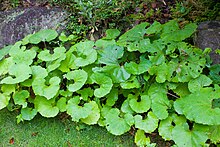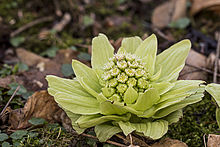Petasites japonicus
| Giant butterbur | |
|---|---|

| |
| Adult fuki | |

| |
| Fuki shoot | |
| Scientific classification | |
| Kingdom: | |
| (unranked): | |
| (unranked): | |
| (unranked): | |
| Order: | |
| Family: | |
| Genus: | |
| Species: | P. japonicus
|
| Binomial name | |
| Petasites japonicus | |
| Nutritional value per 100 g (3.5 oz) | |
|---|---|
| Energy | 59 kJ (14 kcal) |
3.61 g | |
0.04 g | |
0.39 g | |
| Vitamins | Quantity %DV† |
| Thiamine (B1) | 2% 0.02 mg |
| Riboflavin (B2) | 2% 0.02 mg |
| Niacin (B3) | 1% 0.2 mg |
| Pantothenic acid (B5) | 1% 0.032 mg |
| Vitamin B6 | 6% 0.096 mg |
| Folate (B9) | 3% 10 μg |
| Vitamin C | 35% 31.5 mg |
| Minerals | Quantity %DV† |
| Calcium | 8% 103 mg |
| Iron | 1% 0.1 mg |
| Magnesium | 3% 13 mg |
| Manganese | 12% 0.274 mg |
| Phosphorus | 1% 12 mg |
| Potassium | 22% 655 mg |
| Sodium | 0% 7 mg |
| Zinc | 1% 0.16 mg |
| †Percentages estimated using US recommendations for adults,[1] except for potassium, which is estimated based on expert recommendation from the National Academies.[2] | |
Petasites japonicus, also known as fuki (フキ(蕗、苳、款冬、菜蕗)), bog rhubarb, Japanese sweet coltsfoot or giant butterbur, is an herbaceous perennial plant in the family Asteraceae. It exists not only in Japan, but many places in Europe. It is especially commonly found around Swiss alps.[citation needed] It has also been introduced to southern British Columbia by Japanese immigrants.[3]
Uses
The traditional preparation method for this vegetable involves pre-treating with ash or baking soda and soaking in water to remove harshness (astringency), which is a technique known as aku-nuki (灰汁抜き, literally "harshness removal"). The shoot can be chopped and stir fried with miso to make Fuki-miso which is eaten as a relish thinly spread over hot rice at meals. The bulb-like shoots are also picked fresh and fried as tempura. In Korea, it is steamed or boiled and then pressed to remove water. Sesame oil or perilla oil is added in order to make namul.
Toxicity
Like other Petasites species, fuki contains pyrrolizidine alkaloids (PAs) which have been associated with cumulative damage to the liver and tumor formation.[4][5] It also contains the carcinogenic PA petasitenine.[5] The concentration of hepatotoxic PAs can be reduced to a concentration below detection limits with a proper extraction process.[6]
Animal studies
Certain extracts of Petasites japonicus have found to be anti-inflammatory in a study of asthma in mice.[7] Based on additional studies in mice, the plant may contain blood plasma and hepatic lipid-lowering and antioxidant compounds.[8]
References
- ^ United States Food and Drug Administration (2024). "Daily Value on the Nutrition and Supplement Facts Labels". Retrieved 2024-03-28.
- ^ National Academies of Sciences, Engineering, and Medicine; Health and Medicine Division; Food and Nutrition Board; Committee to Review the Dietary Reference Intakes for Sodium and Potassium (2019). Oria, Maria; Harrison, Meghan; Stallings, Virginia A. (eds.). Dietary Reference Intakes for Sodium and Potassium. The National Academies Collection: Reports funded by National Institutes of Health. Washington (DC): National Academies Press (US). ISBN 978-0-309-48834-1. PMID 30844154.
{{cite book}}: CS1 maint: multiple names: authors list (link) - ^ Pojar, Jim; MacKinnon, Andy (1994). Plants of the Pacific Northwest Coast. Lone Pine Publishing. p. 294. ISBN 978-1-55105-040-9.
- ^ Fu, P.P., Yang, Y.C., Xia, Q., Chou, M.C., Cui, Y.Y., Lin G. (2002). "Pyrrolizidine alkaloids-tumorigenic components in Chinese herbal medicines and dietary supplements". Journal of Food and Drug Analysis. 10 (4): 198–211.
{{cite journal}}: CS1 maint: multiple names: authors list (link) - ^ a b Maxim Hirono I.; Mori H.; Yamada K. (1977). "Carcinogenic activity of petasitenine, a new pyrrolizidine alkaloid isolated from Petasites japonicus". Journal of the National Cancer Institute. 58 (4): 1155–1157.
- ^ Kalin P.; Buel E.S. "The common butterbur - Petasites hybridus. Portrait of a medicinal herb: History, pharmacology, clinical applications". Schweizerische Zeitschrift fur GanzheitsMedizin. 14 (5): 267–274.
- ^ Lee J.-S.; Yang E.J.; Yun C.-Y.; Kim D.-H.; Kim I.S. (2011). "Suppressive effect of Petasites japonicus extract on ovalbumin-induced airway inflammation in an asthmatic mouse model". Journal of Ethnopharmacology. 133 (2): 551–557. doi:10.1016/j.jep.2010.10.038.
- ^ Park C.H.; Kim M.Y.; Sok D.-E.; Kim J.H.; Lee J.H.; Kim M.R. (2010). "Butterbur (Petasites japonicus Max.) extract improves lipid profiles and antioxidant activities in monosodium L-glutamate-challenged mice". Journal of Medicinal Food. 13 (5): 1216–1223. doi:10.1089/jmf.2009.1380. PMID 20828319.
